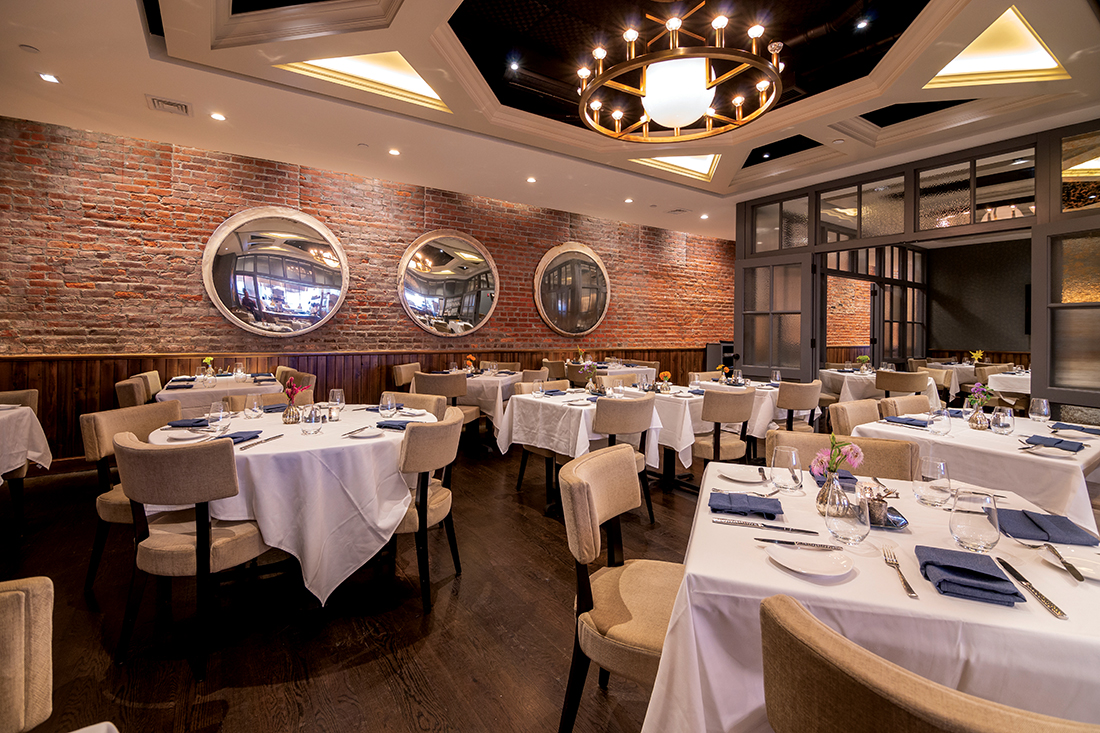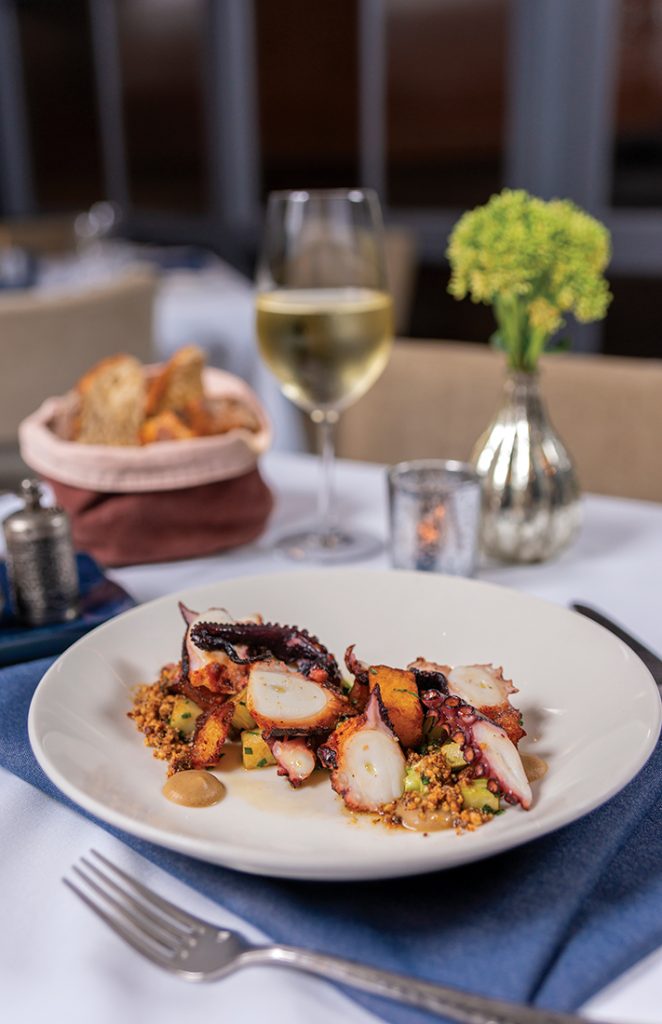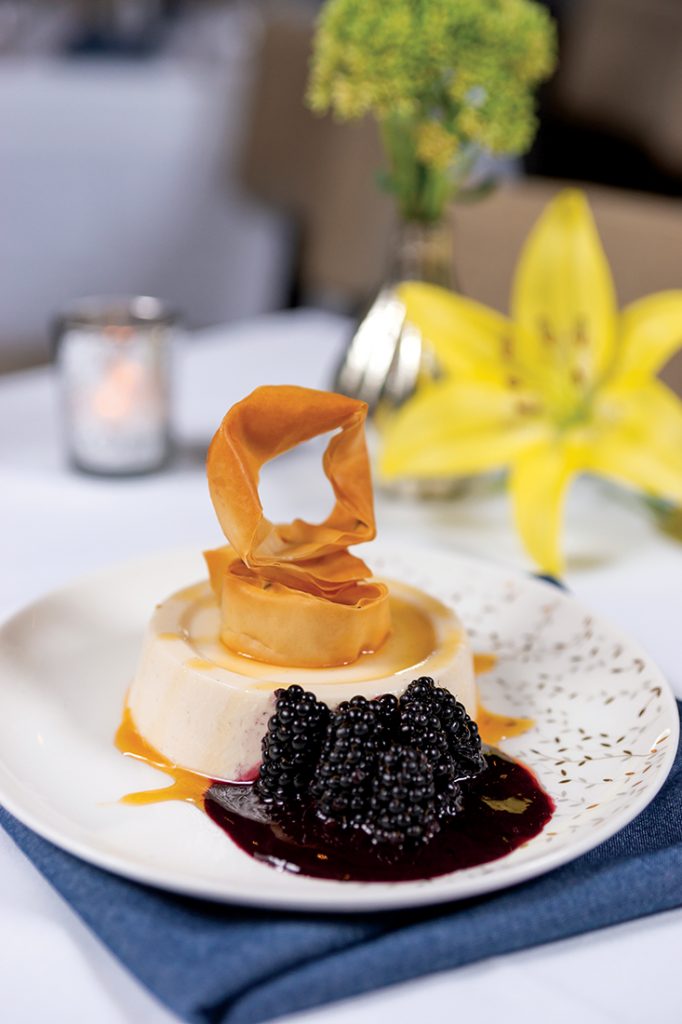The town origin of Summit cites several different theories as to how it got its name. Some general conclusions reference the Summit Lodge; others believe it’s the town’s positioning which rests atop the Watchung Mountains. Then there’s the founder, Jonathan Crane Bonnell, who gave the Morris and Essex Railroad line access to a route that runs through the “summit” of Short Hills.
As unclear as its roots may be, Summit remains a city with a whole lot of charm and respect for its heritage. A reminder of that sits no further than the intersection of Springfield Ave and Maple Street, Summit House Restaurant + Bar. While the eatery itself is new, opening its doors in May 2017, the Summit House name and various incarnations date back to the 1840s. Today, the building in which the restaurant is located shines a bit brighter than its storied past as the city’s first YMCA, thanks to owners, friends and Summit residents Dylan and Melissa Baker and Tyler and Sara Reeder.
After moving to town nearly 10 years ago from Santa Barbara, California, Baker instantly felt the urge to fill the neighborhood’s void for something fresh and contemporary. Baker, whose father was a professional chef, grew up in the restaurant industry and found himself wandering down a similar path years later as a food and beverage manager for Four Seasons Resorts, before moving on to wine and spirit sales. Alongside his now business partners and neighbors, the two couples took on the tumultuous task of restoring a 120-year-old building and laying out the plans for what is now known as the new Summit House.
Taking almost five years from ideation to completion, what they envisioned was a concept that incited the imagination of visitors. What they ended up with was something resembling the likes of a Danny Meyer restaurant, where basic principles such as eye contact and a smile mean as much as the food that’s coming out of the kitchen. Yes, ingredients and technique are of the utmost importance, though the overarching mission is exceptional hospitality.
“We’re not trying to be avant-garde; we’re trying to work within a certain philosophy,” Baker explained to me over dinner. What makes for a great dining experience, we agree, is twofold. Impeccable service and high-quality cuisine are first to come to mind, but other, more modern-day elements to consider are things like design, layout, lighting and artwork.
 Baker, who was a sculpture major in college, viewed the whole project through an architectural lens. For the interior, he turned to Tree House Design, who worked to preserve the DNA of the original Summit House and infuse it with a mid-century modern feel.
Baker, who was a sculpture major in college, viewed the whole project through an architectural lens. For the interior, he turned to Tree House Design, who worked to preserve the DNA of the original Summit House and infuse it with a mid-century modern feel.
“The whole design idea was to pretend that Summit House had been here forever but it’s just been restored,” Baker said. An American flag once owned by Baker’s family is framed in the restaurant’s bar area. It flew over their Connecticut farmhouse in the late 1800s. The flag, Baker came to find out, was commissioned the very same year the building in which Summit House currently resides was built. “I just thought that was amazing. So now we’re a New American restaurant with an old American flag [laughs].” Baker and his team even went as far as to craft the wainscoting from 200-year-old barn wood in order to preserve the building’s rustic integrity and give diners a sense of nostalgia.
Summit House enlisted the help of local builder Orchard Hill, whose portfolio, up until this, consisted solely of residential real estate. “It started making sense to me,” Baker said. “It’s called Summit House and while it’s a restaurant and people only spend a couple hours here at a time, we wanted to build it like a home.”
The front room opens up to the bustling bar area and features street-facing, triple-hung Victorian windows that open wide in nice weather, and an Edwardian-style coffered ceiling. In the back, under the assumption people want to gather and connect, there are two separate seating options: a private room enclosed by frosted glass french doors, and a formal dining area where guests can enjoy views of the open kitchen. Passersby can also get in on the action as they watch Summit House’s chefs shuck Barnegat Bay oysters through their side window on Maple Street.
Not only was Summit House built to be structurally sound, but the executive team behind the restaurant is equally as stacked. General Manager Justin Lord comes to the restaurant from Per Se, where he spent his time as a sommelier working alongside Thomas Keller. Behind the bar is Bobby Frascella, former Iron Shaker competitor and manager of Summit House’s wine and beverage program. And in the kitchen is Chef Aya Hasegawa, who recently took the lead from Chef Martin Kester, both of whom came from Ninety Acres.
“My responsibilities haven’t so much changed, but shifted solely onto me,” Chef Hasegawa said. “This is now my kitchen, my name, my food, my vision. I went from mentee to mentor. Thus far, these shifts have been very rewarding. I pride myself on being a very hard worker and sometimes a perfectionist. Being a female in this industry can be tough but as long as you keep up, show you’re here to work and make great food, it doesn’t go unnoticed.”
 Although Summit House doesn’t take to the farm-to-table moniker, rest assured that what you’re eating is always in-season, made from scratch, locally-sourced and humanely raised. They’re not interested in cutting any corners, going the extra mile to purchase whole cows raised in Far Hills to use for their burgers. They’re also dry-aging all the prime cuts and treating their vegetables as if they were proteins, ensuring that no stalk, leaf or stem goes to waste.
Although Summit House doesn’t take to the farm-to-table moniker, rest assured that what you’re eating is always in-season, made from scratch, locally-sourced and humanely raised. They’re not interested in cutting any corners, going the extra mile to purchase whole cows raised in Far Hills to use for their burgers. They’re also dry-aging all the prime cuts and treating their vegetables as if they were proteins, ensuring that no stalk, leaf or stem goes to waste.
Summit House is also very serious about its bread, which, whether for the table or hamburger buns, is made in-house every day. In fact, they’ve enlisted a staff member to helm the daily bread program and maintain the 25-year-old sourdough starter. They’re also grinding their own spelt flour sourced up the road from Castle Valley Mill in Pennsylvania.
The Summit House menu changes with the seasons, and each new dish is built around local ingredients at their peak. Those are then accompanied by spices and varying textures, and are influenced by regions around the world. During my recent visit to Summit House, their late-summer corn soup was reminiscent of a coconut curry made with sweet corn kernels, actual coconut milk (so it’s vegan) and garnished with a curry leaf.
Chef Hasegawa attributes her inspiration for conceptualizing new dishes to her upbringing. “Being exposed to Japanese cuisine and culture at an early age taught me the time and effort that goes into beautiful food. There was never a shift to seasonality, that is just what I knew. Working at Ninety Acres also taught me about the simplicity of seasonal food, while pulling elements from various ethnicities and using both traditional and modern cooking techniques.”
Other standout starters included the chicken liver mousse topped with apricot preserves and the grilled Spanish octopus with crispy Yukon potatoes, broccoli and brown butter crumble. They’re repurposing the unused broccoli stems from Summit House’s charred broccoli side dish and the key to the octopus, I learned, is to sous vide it first and then finish it to order on the grill.
It’s no surprise that Summit House is also making all of their own pasta in-house daily, and keep one to two pasta-focused dishes on the menu at a time. I tried the campanelle, which I was told diners have been raving about, tossed with corn, mushrooms and a hint of spice. They weren’t wrong.
 The mains at the restaurant come to the table shareably sized, simple in both presentation and composition. No extraneous ingredients here. They offer an impressive wagyu tri-tip, scallops with bacon and other American standards you’d expect to see at a fine dining restaurant, with their own signature twist, of course. To my surprise, Baker boasted about their roast chicken, to which I replied, “I always order the chicken.” It was perfectly juicy on the inside, browned on the outside—everything that Ina Garten taught you a good chicken should be. The way they’re elevating it at Summit House is by adding flavors of apricot, fennel and almond. The halibut, on the other hand, is not to be missed either as it speaks to the soul of true Mexican cuisine. The crisp, flaky fish sits on top of a pozole-style sauce made with fish stock, hominy, green beans and is finished off with a drizzle of chorizo oil.
The mains at the restaurant come to the table shareably sized, simple in both presentation and composition. No extraneous ingredients here. They offer an impressive wagyu tri-tip, scallops with bacon and other American standards you’d expect to see at a fine dining restaurant, with their own signature twist, of course. To my surprise, Baker boasted about their roast chicken, to which I replied, “I always order the chicken.” It was perfectly juicy on the inside, browned on the outside—everything that Ina Garten taught you a good chicken should be. The way they’re elevating it at Summit House is by adding flavors of apricot, fennel and almond. The halibut, on the other hand, is not to be missed either as it speaks to the soul of true Mexican cuisine. The crisp, flaky fish sits on top of a pozole-style sauce made with fish stock, hominy, green beans and is finished off with a drizzle of chorizo oil.
Summit House also makes a conscious effort to consider dietary restrictions when creating their menu so those with food allergies or preferences of any sort can feel safe eating just about anything. All of the soups and sorbets are thickened with coconut milk and any additional cheese or nuts can be removed from things like pasta, main courses, or dessert. “If we can avoid a major allergen until it’s added to finish a dish, therefore it can always be removed, we do it,” Baker said. This mentality makes it so that the entire base of a dish doesn’t have to change based on one preference. I sampled the vegan chocolate pudding, their take on s’mores, served with toasted marshmallows, house-made smoked graham cracker and salted vanilla ice cream (which can be substituted for coconut sorbet).
The bar program follows suit, offering expressions that impart peak, seasonal ingredients. Although Summit House is much more than just a cool, trendy place to grab a drink, if that’s what you want, it’s perfect for that too. The cocktail menu reads as a mix of classics and inventive originals. The Old Fashioned is made with Four Roses Yellow Label bourbon and a Manhattan is composed of High West Double Rye, whiskey cherry Montanaro Vermouth di Torino and maraschino angostura bitters. If you choose to indulge in the latter, the drink comes with an impressive tableside presentation complete with smoke and all. More progressive cocktail iterations include the “Mule of the Moment” and the clarified piña punch—a riff on a tropical colada—made with plantation pineapple rum, velvet falernum coconut water, lime clarified milk and simple syrup.
All these details, even down to the flow of the restaurant where guests and servers are always moving in opposite directions, are central to creating a specific feeling—one where the physical attributes and shiny accessories combine to form a sense of comfort. “All these things are everyday in New York City but rare in New Jersey,” Baker said. “We’re not reinventing the wheel; we’re just trying to move it 25 miles west.”






